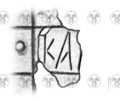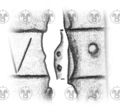SZ-30: Difference between revisions
Gudrun Bajc (talk | contribs) No edit summary |
Gudrun Bajc (talk | contribs) No edit summary |
||
| Line 26: | Line 26: | ||
First published in {{bib|IR}}.<br>Pictures in {{bib|IR}} (photo tav. XLI, fig. a and drawing) = {{bib|LIR}} (photo and drawing).<br> | First published in {{bib|IR}}.<br>Pictures in {{bib|IR}} (photo tav. XLI, fig. a and drawing) = {{bib|LIR}} (photo and drawing).<br> | ||
On fragment A. The presence of the rivetted edge before {{c|K|K2|d}} suggests that this fragment bears the beginning of the inscription.<br> | On fragment A. The presence of the rivetted edge before {{c|K|K2|d}} suggests that this fragment bears the beginning of the inscription.<br> | ||
The signs are struck from what was apparently the inside of the situla, and are usually read from this side, even though dextroverse inscriptions are unusual. It is unlikely that the strokes would have been visible on the outside of the vessel even in the absence of copper rust. (Compare, however, [[index::IT-5]] where the | The signs are struck from what was apparently the inside of the situla, and are usually read from this side, even though dextroverse inscriptions are unusual. It is unlikely that the strokes would have been visible on the outside of the vessel even in the absence of copper rust. (Compare, however, [[index::IT-5]] where the positive side seems to have been the face side.) This raises the question of when and why the signs were embossed. It is generally assumed that the inscription was applied secondarily: The situla was dismantled and inscribed, possibly for votive purposes, on what had been the inside, apparently making use of two decorative lines as a frame for the letters. | ||
{{bibliography}} | {{bibliography}} | ||
Revision as of 13:44, 7 January 2014
| Inscription | |
|---|---|
| Transliteration: | ka[ |
| Original script: | |
|
| |
| Object: | SZ-30 situla (bronze) |
| Position: | inside |
| Frame: | |
| Script: | North Italic script |
| Direction of writing: | dextroverse |
| Letter height: | 2.4 cm |
| Number of letters: | 2 |
| Number of lines: | 1 |
| Craftsmanship: | embossed |
| Current condition: | fragmentary, restored |
| Date of inscription: | 5th–4th centuries BC [from object] |
| Date derived from: | typology [from object] |
|
| |
| Language: | Raetic |
| Meaning: | |
|
| |
| Alternative sigla: | IR 29 A LIR SA-22 A |
| Sources: | Schumacher 2004: 139 |
Images
|
Inscription SZ-30 - fragment A.
|
Inscription SZ-30 - fragment B.
|
Inscription SZ-30 - fragment C.
|
Inscription SZ-30 - fragments D and E.
|
Inscription SZ-30 - fragment A.
|
|
Object SZ-30 situla with inscription SZ-30 - fragments A-K.
|
Object SZ-30 situla with inscription SZ-30.
|
Commentary
First published in IR.
Pictures in IR (photo tav. XLI, fig. a and drawing) = LIR (photo and drawing).
On fragment A. The presence of the rivetted edge before ![]() suggests that this fragment bears the beginning of the inscription.
suggests that this fragment bears the beginning of the inscription.
The signs are struck from what was apparently the inside of the situla, and are usually read from this side, even though dextroverse inscriptions are unusual. It is unlikely that the strokes would have been visible on the outside of the vessel even in the absence of copper rust. (Compare, however, IT-5 where the positive side seems to have been the face side.) This raises the question of when and why the signs were embossed. It is generally assumed that the inscription was applied secondarily: The situla was dismantled and inscribed, possibly for votive purposes, on what had been the inside, apparently making use of two decorative lines as a frame for the letters.
Bibliography
| IR | Alberto Mancini, "Iscrizioni retiche", Studi Etruschi 43 (1975), 249–306. |
|---|---|
| LIR | Alberto Mancini, Le Iscrizioni Retiche [= Quaderni del dipartimento di linguistica, Università degli studi di Firenze Studi 8–9], Padova: Unipress 2009–10. (2 volumes) |





